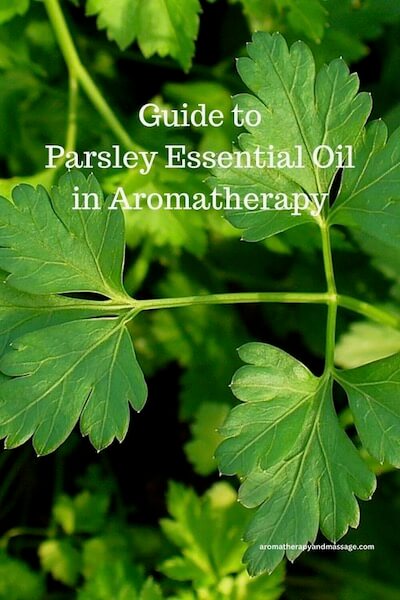- Home
- Essential Oil Profiles
- Parsley Essential Oil
As an affiliate for Bookshop, Amazon, and other programs, I may earn a small commission for products purchased through links. This doesn't affect the price you pay. Privacy policy and disclosures.
Search this site:
Guide to Parsley Essential Oil Benefits and Uses
Some sources recommend against the use of parsley essential oil (Petroselinum crispum or Petroselinum sativum) because it contains apiole, which is potentially toxic.
However, the apiole content of parsley seed essential oil (the most commonly available oil, though a parsley leaf oil is also produced) can vary from 11.3–67.5%. If you choose to use the seed oil, use it cautiously.

Parsley leaf oil contains less apiole and may be safer, but I didn't find much reliable information on this oil.
Plant family: Apiaceae
Production: Steam distilled from the seeds (or the leaves for parsley leaf).
Aroma: Herbaceous, green and slightly woody.
Perfume/Aromatic note: Middle. The seed oil is used in perfumes, especially colognes for men and mixes well with spicy essential oils.
Is parsley safe to use during pregnancy? No, and do not use during breastfeeding.
Is parsley essential oil safe for children? Do not use with young children. Consult a professional about use with older children.
Main components:
Parsley seed oil has three chemotypes, with either parsley apiole, myristicin, or allytetramethoxybenzene as the main constituent. Most commercial oils contain a high percentage of parsley apiole.
Parsley Seed
- parsley apiole 11.3–67.5%
- myristicin 0.7–37.9%
- allytetramethoxybenzene 0.6–29.0%
- alpha-pinene 8.3–16.9%
- beta-pinene 5.4–10.7%
Parsley Leaf
- p-mentha-1,3,8-triene 6.2–45.2%
- beta-myrcene 7.8–23.8%
- myristicin 1.9–8.8%
- dill apiole 0.2–5.2%
Source: Essential Oil Safety, 2nd Edition
Cautions: Do not use the seed oil if you have kidney disease. The seed oil may cause skin irritation and sensitization. Essential Oil Safety recommends a dermal maximum of 1.1% and notes possible drug interaction and a risk of toxicity to the liver and kidneys.
Parsley Essential Oil Benefits and Uses
The Encyclopedia of Essential Oils (updated edition): Parsley seed may help relieve arthritis, broken blood vessels, cellulitis, rheumatism, sciatica, flatulence, indigestion, hemorrhoids, missing periods, and menstrual pain.
The Complete Aromatherapy & Essential Oils Handbook for Everyday Wellness:
- Parsley helps shrink small blood vessels, making the oil useful for hemorrhoids, bruising, and thread veins.
- The oil has a diuretic action that may increase urine flow and reduce water retention during menstruation or other conditions where edema occurs, such as swollen ankles and PMS. However, the oil is not recommended for painful periods, as it could cause cramping (note this recommendation is different from two other sources that do suggest the oil for menstrual cramp relief).
- The essential oil is a good digestive aid that simulates appetite, helps digest food, and eases nausea and gas.
- Do not use at a dilution greater than 0.5%.
Essential Oils All Natural Remedies: Use parsley seed at a dilution of less than 1%. The oil may have the following benefits:
- Strengthens blood vessels, which may help tone varicose veins and slow down the spread of broken facial capillaries.
- Supports hair growth when diluted in carrier oil for a scalp massage.
- Helps relieve arthritis and rheumatism pain.
- Acts as a diuretic that can help reduce fluid retention and is also a mild laxative.
- Helps relieve stomach aches, indigestion, nausea, vomiting, and flatulence. Overall, the oil strengthens and tones the digestive system.
- Calms and grounds the mind and emotions and soothes the nerves. The oil may also enhance focus, support a strong sense of purpose, and give you more confidence to overcome difficulties.
- Tones skin and may help relieve acne, pimples, and skin infections. To make a facial elixir to help fade spider veins, blend 1 drop parsley essential oil and 2 drops rose essential oil in 1 tablespoon carrier oil. Gently massage a little of the blend over the spider veins.
AromaWeb: Parsley seed essential oil has a diuretic effect and may help shrink blood vessels. The oil's aroma adds an herbaceous note to blends. Using this essential oil in the bath creates greater risk of irritation and sensitization—do not add the oil to bath blends.
Jade Bloom: Parsley seed helps remove toxins from the skin and has astringent properties that constrict pores and improve skin complexion. The essential oil may help relieve varicose veins, increase circulation, reduce nausea, calm muscle spasms, and cleanse and disinfect wounds and irritations. The oil also acts as a scalp and hair tonic.
- The rasa (taste) of parsley seed is pungent and bitter, the vipaka (aftertaste) is pungent, and the virya (energy) is heating/drying.
- The oil decreases vata and kapha increases and pitta.
- Tissues most affected by the oil are plasma, blood, and muscles.
- Indications for this essential oil include edema, swollen glands, swollen breasts, absence of periods, painful menstruation, and sciatica.
Mixing Essential Oils for Magic: Parsley is a powerful ally for element magic, ritual purification, and general protection. The oil supports balance and concentration, astral work, initiating renewal, and bringing in fresh, new beginnings.
Buy essential oils: Aromatics International or Rocky Mountain Essential Oils.
Photo Credit: H. Zell, CC BY-SA 3.0, via Wikimedia Commons



